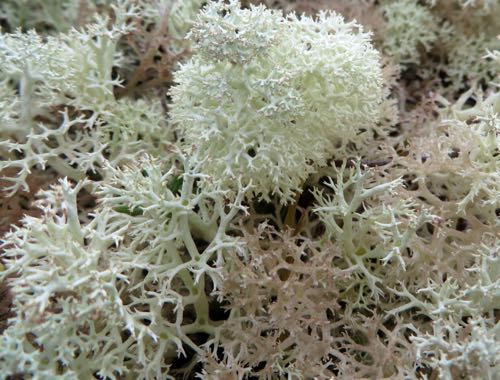 The tundra - home to the cryptogams; moss and lichen
The tundra - home to the cryptogams; moss and lichen
Tangled Up in Classification
Classifying and organizing living organisms helps us to understand patterns and functions in the natural world. However, the systems we create often get muddled and need to be revised as we acquire more knowledge, an acquisition which is speeding up with genetic sequencing. Cryptogam is a word that was once used to describe those "plants" that did not reproduce by seeds, but reproduced by spores and included lichen, moss, ferns, algae and fungi. But this classification system obviously does not work, as fungi as we know, are not plants, but rather belong in iheir own separate kingdom.
For the sake of brevity and my lack of expertise, I will split off from the fungi, and devote this post to sharing my tundra-tromping experiences with those spore-forming, charming organisms of the arctic, the moss and the lichen.
Zombie Moss
Last spring, my students and I read about a moss that began to re-grow after being buried under snow and ice for 1,500 years. Mosses belong to a group of organisms called bryophytes and are defined by their poor water and food transportation systems. So if water is not abundant or easily accessible to all parts of its body, the moss will quickly die, unless it has developed a work-around to drought or famine. Mosses, like the zombie moss that came back to life after 1,500 years of dormancy, will dry up or desiccate, appearing as a lifeless hull when deprived of water or light. But somewhere deep within its genetic instructions, the moss has a "light" switch which tells it to wake up when more life-affirming conditions return. Just add water, a little visible light, and presto, life comes back to the moss. Scientists even speculate that this ability to dry up and go to sleep when temperature, light and water are absent may be how life got started here on planet earth. An extra-terrestrial moss who hitched a ride on a meteor that struck the earth...
 This red-brown moss glistens with water
This red-brown moss glistens with water
To read more about the zombie moss: http://gettingthepicture.info
Sphagnum Moss
As I have squelched up and down on the spongy mass of sphagnum, I have been quite ignorant of this interesting group of organisms. As a gardener, I know that the peat moss is a great absorber of water and is formed from sphagnum often taking decades to grow, and therefore its use as a soil amendment is an unsustainable practice. But that is pretty much all I had known. I did not know, for example, that the tundra under my feet is home to a complex web of at least 5 species of sphagnum moss, and that when you tweeze the mass of moss apart, each species looks quite unique. Some of the strands are not even sphagnum but members of other moss genera and up close, look like miniature pine trees! A 5X magnifying glass gets you up close to appreciate the intricacies of the moss shape and form.
 A close up view of moss on the tundra, the moss is the shorter, darker green plant
A close up view of moss on the tundra, the moss is the shorter, darker green plant
Symbiosis and the Lichen
Over 15,000 species of lichen inhabit the terrestrial world. But to say that a lichen is a species, is again, a bit of a classification entanglement. Lichen are actually two organisms living together to get the tough job of survival done in an extremely inhospitable space. Lichen is an association of a fungus and an algae. This symbiotic relationship benefits both organisms, the fungus gains energy from the sugars that the algae manufactures during photosynthesis and the algae gains a protective house inside the fungi, as well as scamming some sorely needed mineral nutrients that only the fungus has the fortitude to pry loose from the bare rock or otherwise harsh living conditions. To learn more about mosses and lichen read "Mosses, Lichens and Ferns of the Northwest North America", by Vitt, Marsh and Bovey.
 A fruticose Lichen - maybe this is foam lichen?
A fruticose Lichen - maybe this is foam lichen?
 Fruticose Lichen; maybe foam lichen?
Fruticose Lichen; maybe foam lichen?
 A fruticose lichen called Toy soldier found on the alpine tundra in Alaska
A fruticose lichen called Toy soldier found on the alpine tundra in Alaska
Lichen cover the tundra in as much diversity and splendor as the mosses and mushrooms that have delighted me since I have arrived in Alaska. The colors and forms of these organisms are sometimes muted and delicate, and other times bold and sharp. Lichens are classified into three main categories, Fruticose, Crustose and Foliose, depending on the way they function as well as how they are formed. Naming and identification of these organisms will take more time than I have to learn on this Alaska experience, but surely I will not forget the name of this splendid little lichen; FAIRY BARF! The little pink pads look a lot like, well, fairy barf. OK, I am sure this is not the scientific name, but it should be.
 A Crustose Lichen called Fairy Barf!
A Crustose Lichen called Fairy Barf!

Comments